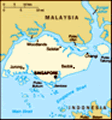Advertisement
Published: April 27th 2018
I’m a little embarrassed that I don’t know more about Dr. Sun Yat-Sen, considering I keep bumping into him on my travels. Well, not literally, (the guy’s been dead for more than 90 years) but I’ve seen statues and memorials to him in San Francisco, Hong Kong, and Tokyo, to name a few places. And I came across one more in Singapore, on my way to the Burmese Buddhist temple.
I really didn’t know much about Dr. Sun. I had this vague idea that he was involved with Taiwan, (ROC, Republic of China) and that he was a revolutionary bent on overthrowing the Qing Dynasty. To foster democracy, he founded the Chinese Nationalist Part – the Kuomintang – or maybe he was a communist. Or both! And maybe he had hand in the triads, the Chinese version of organized crime.
It’s difficult to separate fact from legend, but few things ring true. He was born in China in 1866, and died in 1925 at the age of 58. He moved with his brother to Honolulu when he was 13, and attended the Iolani School and Oahu Collage. He was baptized in Hong Kong in 1884 by an American missionary
of the Congregational Church of the United States. He later studied medicine at the Hong Kong College of Medicine, and was granted his medical license in 1892.
Other people have written far more detailed histories of Sun Yat-sen, but suffice it to say he supported the revolutionaries who wanted the overthrow the Qing dynasty. You know how old Westerns used to depict Chinese males by showing them with a long braid? Under the Qing dynasty, males were required to wear their hair in a queue as a symbol of submission. Failure to do so was punishable by execution for treason.
When Dr. Sun cut his queue in 1895, he fled to Japan and spent the next sixteen years living in exile. He continued to work to overthrow the Qing, and when the Qing dynasty fell in 1911, Dr. Sun was in the United States. He was asked to come back to China by the revolutionaries, and was sworn in as China’s first president. His presidency lasted only 45 days until he stepped down in favor of a more powerful politician.
During his travels while in exile, he spent some time in Singapore. When in Singapore, he stayed
at the villa of Teo Eng Hock, a rubber trader, on four separate occasions between 1906 and 1920. It was here that the Wuchang uprising, which brought about the overthrow of the Qing Dynasty, was planned.
For a revolutionary, the villa is pretty nice accommodations. Teo had bought the villa for his mother, and renamed it Wan Qing Yuan, or Serene Sunset Garden. It is not known what mom thought of Dr. Sun and his friends plotting a revolution in her living room, but the building and grounds are open and airy.
The villa served as a base in Singapore for Dr. Sun and his Chinese Revolutionary Alliance. Planning for the overthrow of the Qing, along with fundraising for the cause, was centered here. After the Qing Dynasty fell, this became the local headquarters of the Kuomintang – the Chinese Nationalist Party.
During the Second World War, the Japanese occupied Singapore and used the villa as a communications center, and as the headquarters of the Kempeitai – the dreaded Japanese Military Police. The Japanese destroyed most of the contents of the villa, including furniture and documents. I won’t go into it here, but you cannot overstate the
brutality of the Japanese towards the Chinese in Singapore during the occupation, both for their resistance to the Japanese, and their fundraising for the effort to defeat the Japanese in the war.
After WWII, the Chinese Nationalist Party paid to restore the hall and set up the Singapore branch of the Nationalist Party. However, when the Communists won the Chinese Civil War in 1949 and established the People’s Republic of China, the British forced the Singaporean Kuomintang branch to close. The Nationalist Party moved to Taiwan where it remains a political party today.
The Sun Yat Sen Memorial Hall is worth a visit, especially if you are interested in this period of history. For a busy city like Singapore, the grounds are an unusual expanse of calm. The building itself has been nicely refurbished, and showcases the history of a revolution. Not many people come here; the only folks I saw were a small group of older Chinese ladies on a history tour.
Possibly Useful Information: • · The closest MRT stops are Novena and Toa Payoh, both on the North-South line.
• · Opening hours are Tuesday to Sunday 10am–5pm, it is closed on
Monday
• · Admission is S$6.00, free for Singaporean citizens and Permanent Residents
• · Guided tours are available in English and Mandarin; check the Sun Yat Sen Nanyang Memorial Hall website for days and times.
• Sun is referred to as the "Father of the Nation" in the Republic of China (ROC) and the "forerunner of democratic revolution" in the People's Republic of China (PRC)
Advertisement
Tot: 0.282s; Tpl: 0.014s; cc: 36; qc: 128; dbt: 0.1384s; 1; m:domysql w:travelblog (10.17.0.13); sld: 1;
; mem: 1.4mb










gangopa
tab gangopadhyay
Plotting a revolution in her living room
We read about the Dr. in our school history, but coverage was not as elaborate. Glad to read the background and the history as you have drawn. Good story.